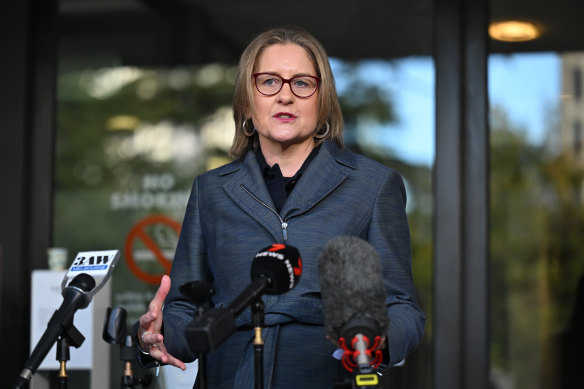Why unions believe Victoria’s hospital shake-up was a missed opportunity
By Henrietta Cook and Kieran Rooney
Health unions have slammed Victoria’s hospital shake-up as a missed opportunity and say the state’s “hopelessly fractured” system is leading to poor outcomes for patients and workers.
They include examples in which ambulances are driving from regional Victoria into Melbourne rather than taking patients to established hospitals on the suburban fringe.

Victorian Premier Jacinta Allan has announced the new health services plan.Credit: AAP
On Thursday, amid mounting community pressure, Premier Jacinta Allan rejected a 179-page Health Services Plan recommendation to forcibly amalgamate the state’s 76 health services.
Victorian Allied Health Professionals Association secretary Craig McGregor said his union had been advocating for hospital mergers for many years to improve co-ordination across health services.
“The Victorian health system is hopelessly fractured,” he said. “The government struggles to influence health services.”
This lack of co-ordination was particularly apparent during the pandemic, he said, with each hospital having its own rules around infection controls. He said there were also stark differences in workplace conditions.
“Some departments are far safer, while in others, junior staff are just thrown into the deep end far too early.”
He said too many chief executives on health service boards had a “parochial interest in keeping their jobs”.
Danny Hill, the secretary of the Victorian Ambulance Union, said paramedics were frequently transporting patients great distances between regional and metropolitan hospitals, bypassing suitable hospitals that were much closer.
He said this was because hospitals were not co-ordinating the best response for patients.
Hill questioned whether the government’s response to the Health Services Plan – which will involve grouping health services into geographic regions with their own boards but also retaining the state’s 76 independent boards – would address this issue.
“We end up taking patients from Wonthaggi hospital to The Alfred hospital but might drive past Casey and Frankston hospital,” he said. “For whatever reason, they are transferring them further away. It ends up taking crews from the Gippsland area down to Melbourne.”
He said NSW’s eight local health networks operated much more effectively.
“Victoria’s health services are run like Squid Game at the moment – they are all working against each other,” Hill said.
Roderick McCrae, the president of the Victorian branch of the Australian Salaried Medical Officers Federation, said amalgamating services could have improved referral pathways and training for doctors.
“It’s a completely missed opportunity,” said McCrae, who has recently been appointed to the board of a regional health service. “It would have ultimately led to better knowledge sharing and ultimately better patient care.”
He said that while the people sitting on health service boards were very caring, it was inefficient to have 76 boards operating in one state.
Australian Nursing and Midwifery Federation Victorian branch secretary Lisa Fitzpatrick said she had supported the plan’s recommendation to move from 76 to 11 networks.
“We hope that recommendation will be adopted and enlivened when the system is ready for it,” she said.
“We wholeheartedly support health services being required to fix inefficiencies and introduce important measures such as one statewide payroll system instead of the current 19, and electronic medical records.”
Speaking on ABC Radio on Friday, Health Minister Mary-Anne Thomas said the government had listened to community concerns when it decided to rule out forced amalgamations.
“In smaller communities, people want to know that they can get the acute care that they need and that they don’t have to wait for it,” she said.
“It’s not acceptable to me that in the regions you might have a doctor ringing around some of our major Melbourne hospitals trying to find a bed.”
“Rural and regional Victoria need to get their acute care needs met without a fight with the bigger hospitals. That’s what I want to see being delivered as a consequence of establishing these networks.”
Opposition health spokeswoman Georgie Crozier said she believed the Local Health Service Networks were “amalgamations by stealth”.
“They’re placing a mega-board over the top of those with a ministerial adviser, so those local voices will not have the impact that the communities want and expect,” she said.
Australasian College of Emergency Medicine Victorian faculty chair Dr Mark Putland said while amalgamating health services was daunting, it offered a great opportunity to improve care.
“Stepping back from the system reform plan … is disappointing,” he said.
“We want to make sure we find ways to work together to co-ordinate care better so that nobody slips through the cracks of our very separated health services.”
Get the day’s breaking news, entertainment ideas and a long read to enjoy. Sign up to receive our Evening Edition newsletter here.